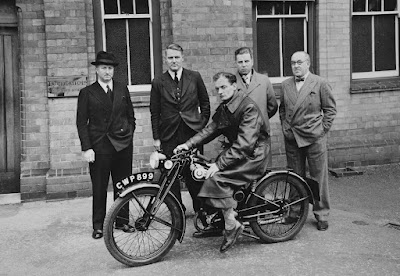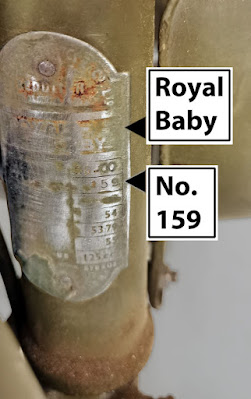 |
| It's a rare Royal Enfield in disguise as a more common Flying Flea. |
The story of a rare Royal Enfield "Royal Baby" motorcycle -- discovered in disguise! -- appears in the June/July edition of The Gun magazine, the publication of the Royal Enfield Owners Club UK.
Club member James Boaden of the UK wrote about how he found his "Baby" and how he determined it really was one of the very few of its kind Royal Enfield built before World War II intervened.
Built as a stick-in-the-eye to the Nazis, the Royal Baby design would serve as the prototype for the Royal Enfield Flying Flea, built in thousands for the Allied war effort.
James was kind enough to share his story with me, and to answer a few additional questions I had.
He ended his original account with the words "there are times when you should trust your heart and not just your head." Here is the rest of his story, as he wrote it for The Gun:
"So, I am sat in my kitchen passing the time of day on Google when I spot a very strange motorcycle being advertised; according to the advert it is a 1939 Royal Enfield Royal Baby. If the advert is true it is a very rare motorcycle but it has sat there for six months and looking at the pictures is clearly a late '40s RE125 dressed up as a wartime Flying Flea... or is it?
"In 1934 DKW of Germany launched a new, small motorcycle at a very moderate price, the RT 100 (ReichsTyp 100cc). The RT was very popular with the Hitler Youth.
"In the autumn of 1938, the Dutch importers Stokvis en Zonen were facing a problem as their board of directors contained Jews; the Nazis arranged that Stokvis lost their DKW motorcycle franchise overnight.
"Stokvis weren't happy and they started looking for a replacement for their best seller. After rejection at Velocette in Hall Green, Stokvis put the proposition to Tony Wilson-Jones at Royal Enfield and in less than six months Enfield had measured up the whole motorcycle and built a prototype for approval by Stokvis.
 |
| Royal Enfield and Stokvis executives with their Royal Baby at the Royal Enfield works in Redditch, England. |
"In April 1939, two hand-built prototypes were shipped to Rotterdam to show to the Dutch public. The orders started to come in. In July 1939 the Royal Enfield factory in Redditch started production of the Royal Baby.
"Approximately 190 RBs were made from July 1939 until the spring of 1940, but on the 10th of May Germany invaded the Low Countries.
"In 1942 the Air Landing Brigade made orders for two RB type motorcycles, and these were the basis for the development of the WD/RE Flying Flea, which was parachuted into Arnhem and Normandy amongst other war zones.
"Although few survive, a lot of historical information is available on the thousands of Redditch made Flying Fleas built for airborne operations and the parachuting frames made for them at Royal Enfield in Calton Hill, Edinburgh. But very little information exists on the original RB.
 |
| The Royal Baby design led to the famous Flying Flea. |
"Enough history and back to the present, the motorcycle is in Holland and Covid restrictions make it rather difficult to just go and take a look; it should have been time to forget about it, but I keep being drawn back to it and decide to do some research. From the pictures I can get huge amounts of information on the construction of the motorcycle, and it also seems to have matching frame and engine numbers so the REOC should be able to help.
"A few calls to Graham Scarth (REOC Chairman), Bob Murdoch (REOC Archivist) and Don McKeand (REOC Specialist) give me all the information I need as the numbers claim that it is an RB delivered to Stokvis in July 1939; unfortunately the frame number has clearly been scratched on at a later date and the engine number photograph looks dodgy too, quite clearly a fake.
"My problem now was with the factory pictures of the RB as there were a number of clear indicators. The motorcycle is presumably a fake but what is it?
"It is not a Flying Flea or even a post-war RE125; could somebody, just possibly, have dressed up a genuine RB as an RB without realizing what they had? Although the dealer selling the motorcycle is totally reputable, I am fearful of asking too many questions as it may drive the price up or bring further interest; more research is required.
"Discussions with owners of WD/RE motorcycles revealed a slight difference in the engine which would confirm it was an RB engine; this could clearly be seen in the photographs and was much more conclusive than a later fitted cover or the like. The engine was definitely from an RB.
"Further research on Google revealed that the RB had a VIN plate mounted on the front of the frame to mimic the plate fitted to the RT100 motorcycle. From the photographs this could possibly still be present but covered with paint.
 |
| Badge found on headstock revealed Royal Baby No. 159. |
"I bravely asked the dealer to rub the area with paint stripper to see what was revealed, I also promised to buy it if what was revealed confirmed the details. The result, although not conclusive triggered my purchase.
"After two weeks a pallet turns up with a motorcycle on it and I nervously start looking at it. The photograph of the engine number was a bad picture, and the number is clear to see; further checks revealed that the factory stamped number on the rear engine lug is also correct. The frame number has, as thought, been scratched on but upon removing the petrol tank the same number original stamp is revealed.
"My illogical thoughts from a few months earlier have led to ownership of the earliest recorded Royal Enfield Royal Baby, which left Redditch on July 31, 1939 and one of the rarest Royal Enfield motorcycles on the planet."
With that dramatic statement I asked James what he plans to do with his disguised Royal Baby. Here are his replies to that and other questions I posed.
"The Royal Baby is to be restored as a civil bike exactly as originally supplied. The military look it currently has I suspect was somebody trying to make it look like a War Department Flying Flea; if it is for a genuine reason I cannot expect to trace the facts on this.
 |
| Original Royal Baby, top, and James' Royal Baby as found. |
"Three years ago I bought my first Royal Enfield, a pile of rust that was once a 1960 Prince. Since then things have moved on and I now have the 1960 Prince, two 1954 Ensigns, one 1953 Ensign, two 1950 RE1s (Flying Fleas), two 1948 RE1s, the 1939 Royal Baby, a 1938 Model A, a 1934 Model A, a 1925 201, a 1925 201A and a 1922 201. They are all at differing stages of rebuild.
"It is not commonly known but the RB was never marketed by Royal Enfield and when they introduced it in England as the RE125 in 1940 it all changed back and there was no plate on the front. Any left over RBs were not sold in England and it is thought that when the army wanted the Flying Flea they were given left over RBs. The first purchase contract actually says 2 x DKW RB 125 Motorcycles, which confuses things even further but tends to suggest they were RBs."
James is working on documenting the history of the Royal Baby. Luckily he speaks Dutch, permitting him to translate articles and historical documents in that language. It seems as though his Royal Enfield Royal Baby is lucky to have found an owner that appreciates its importance.


























The editor of The Motorcycle, Arthur Bourne (pen name Torrens, which is latin for "a bourne or stream" neat eh?) was instrumental in getting these little bikes accepted by the military in 1942 as told in his memoir "Behind the Scenes in the Vintage Years".
ReplyDeleteThe book is available on Amazon if you are interested: https://www.amazon.co.uk/Behind-Scenes-Vintage-Torrens-Arthur/dp/1785898523/ref=sr_1_1?crid=2T0AIOVC5M8BS&keywords=behind+the+scenes+in+the+vintage+years&qid=1658213611&s=books&sprefix=beind+the+scenes+in+the+vintage+years%2Cstripbooks%2C313&sr=1-1
My name is Joop van Heusden and I am a cousin of the Dutch technician from Stokvis in Rotterdam with the same name. I have extensive info, data and pictures of The Royal Baby. Including articles written by the designer in 1939 and further. There is an original RB in the Netherlands and it is in running condition. A letter of me was published in The Gun in 2004 # 179. More info: j.g.van.heusden@hccnet.nl
ReplyDelete